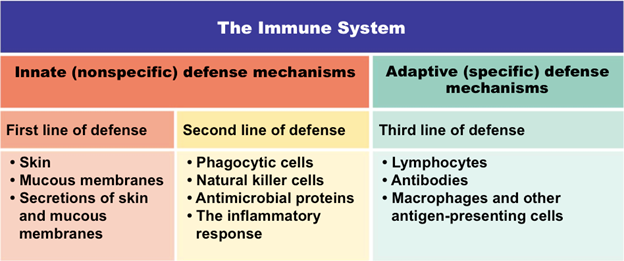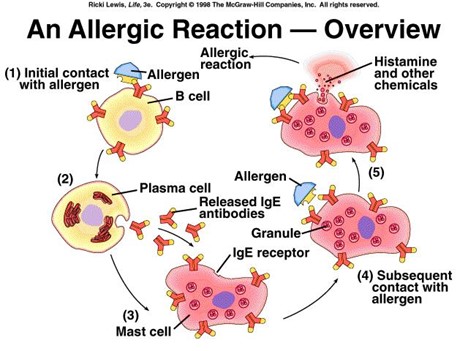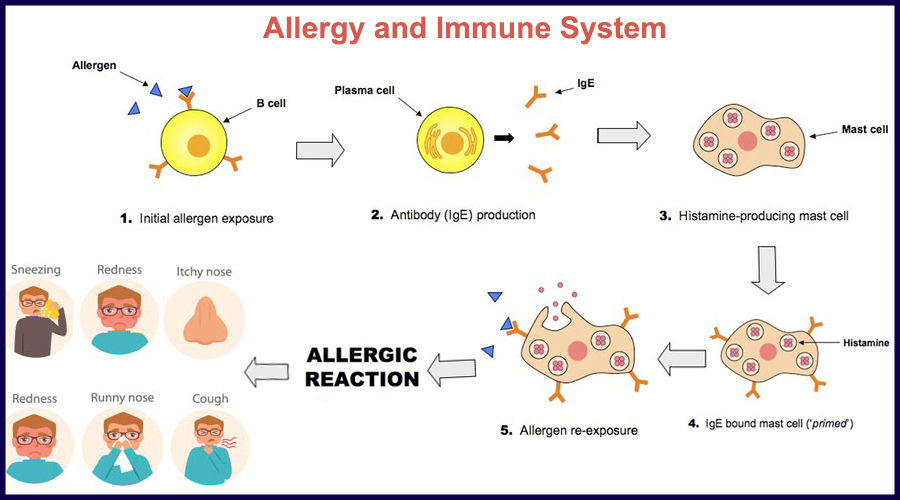Food allergies are a medical condition where a person experiences a reaction upon consuming certain foods. These reactions are specific to certain foods that can vary for each individual, and symptoms often include an itchy mouth, hives and rashes, stomach pain, nausea, vomiting, trouble swallowing, trouble breathing, and even death. But how can a perfectly ordinary food cause so many problems for certain people? How does an allergic reaction work and why do only certain people have these reactions to foods that everyone else can consume normally? The answers to these questions lie with a deeper understanding of the biological and chemical mechanisms of a food allergy.
Food allergies are a condition that stems from the immune system of the body. Thus, a basic understanding of the immune system under normal circumstances is necessary in order to understand the immune system’s role in the body of an allergic individual.
Key Terms in Immunology
| Key Terms | Definitions |
|---|---|
| Immune system | The system that protects the body from foreign invaders and helps prevent disease |
| Pathogen | An organism or virus that causes disease (ex: viruses, bacteria, fungi, parasites, worms, etc) |
| Antigen | A molecule recognized as “not self” by the immune system, thus causing an immune response |
| Antibody / immuno-globin | A protein released by B cells in response to a pathogen that recognizes and attaches to antigens in order to tag them for destruction; immunoglobin E plays a key role in allergic reactions |
| Innate immune system | The nonspecific immune response consisting of the first and second lines of defense |
| Adaptive immune system | The specific immune system consisting of the third line of defense |
| Lymphocyte | A white blood cell, such as a B cell or T cell |
| B cells | White blood cells that produce antibodies |
| T Cells | White blood cells that can either activate B cell (helper T cells) or kill infected cells (cytotoxic T cells) |
| Cytokines | Substances secreted by the immune system that help coordinate the immune response |
| Humoral immunity | The immune response directed by B cells |
| Cell mediated immunity | The immune response directed by cytotoxic T cells |
An Intro to the Immune System
The immune system is in charge of keeping the body safe from disease causing foreign invaders called pathogens (viruses, bacteria, parasites, etc.). When a pathogen enters the body, the immune system recognizes particles on the pathogen called antigens and ultimately enacts a response that serves to eliminate the pathogen. In order to do its job, the immune system consists of three different lines of defense. The first two are considered nonspecific, meaning that they attack anything foreign, while the third is considered specific, meaning that white blood cells recognize specific antigens and carry out a targeted immune response.
The Three Lines of Immune Defense
First, the immune system consists of the nonspecific defense system, otherwise known as the innate immune system. In the first line of defense against pathogens are the skin and mucous membranes in the eyes, nose, and mouth. If a pathogen makes it past the first line of defense, then secondary defenses will kick in.

The secondary line of defense consists of a series of events that together consist of the inflammatory response. When a pathogen breaks through the skin (such as bacteria on the end of a splinter), chemicals such as histamine are released. These chemicals increase blood flow to the area and cause inflammation. The inflammatory response can cause the symptoms characteristic of an infection, such as fever or pain. Phagocytes, a type of white blood cell, will travel to the site of inflammation and engulf the pathogens. Phagocytes will break down the pathogen and can display fragments of the pathogen’s antigen on their own cell surface to help activate other immune cells. These phagocytes become known as antigen presenting cells and play an important role in the third line of defense.
Following the first and second lines of defense, the third line of defense will occur. Unlike the first two nonspecific responses, the third line of defense is specific. In the third line of defense, immune cells known as B cells and T cells recognize pathogens as “non self” by binding to their antigens. When B cells are activated, they produce antibodies which help destroy pathogens. There are a variety of different antibodies, but the 5 main types of classified as IgG, IgM, IgA, IgD, and IgE.

When T cells are activated, they can either become helper T cells which activate B cells or cytotoxic T cells which destroy infected cells. Both B cells and T cells can turn into memory cells, which help jump start the immune response if the body encounters the same pathogen at a later date.

The Immune System in Allergies
Overall, the job of the immune system is to attack foreign invaders in order to keep the body healthy. However, in an individual with food allergies, their immune system mistakenly interprets certain foods as harmful pathogens. In these cases, an IgE antibody will recognize an allergen and prompt an allergic reaction by releasing histamine and other chemicals, usually by means of multiple intermediary cells such as mast cells, basophil cells, or eosinophils. These chemicals cause the symptoms of an allergic reaction such as coughing, itching, trouble breathing, etc. Moreover, these chemicals often operate in a cyclical fashion, meaning that they prompt B cells to produce more IgE, which causes more chemicals to release, which causes more IgE to be produced, and so on. Thus, mild symptoms can quickly spiral into a full-scale allergic reaction if left untreated.

- First exposure to an allergen (sensitization) – the immune system will recognize the allergen and B cells will produce IgE antibodies that specifically target the antigen of the allergen
- Subsequent exposures (early phase) – when a person consumes the antigen a second time, the IgE antibodies will recognize the allergen and prompt mast cells to release chemicals such as histamine, which causes symptoms; mast cells also promote the production of more IgE from B cells
- Post reaction symptoms (late phase) – following the primary allergic reaction, the immune system can continue to release chemicals that contribute to nasal congestion and lingering symptoms for up to 48 hours following the exposure
Scientists are still researching why some people have food allergies while others do not, but an understanding of the biochemical mechanisms of an allergic reaction is the first step to understanding the root causes of a food allergy. Interested in finding out more? Check out our article sources below!
Article Sources

